Winter Blues
... 'tis the Season ...
Does this Resonate?
Some days the hi-fi sounds fabulous and others it's 'unlistenable'. You play a treasured disk, only to wonder 'What makes this a treasure?'
It's been an annoyance since I developed this neurosis. Discussions among consonantly cursed comrades indicates this malady is wide spread in hi-fidom. What could possibly cause such an affliction? [Other than insanity and / or other neurosis?] As even today's mid-fi components are assembled from high tolerance components on sophisticated computer controlled assembly lines, the unit to unit variablilty of decades past should no longer be a problem. They maybe mediocre, but they will be consistently mediocre.
I've mentioned elsewhere that our then Rotel RX-1050 took about 45 minutes playing for optimum sound. This interval was determined in the heat of the Los Angeles summer, with evening temperatures near 75°F. The ambient temperature during the day in our den could be as high as 85°F. Hence, when powered, the amp is somewhat warm. In November 2003, we had a cold snap with evening temperatures dropping below 40°F. With the den at 66°F, we found, dependent on program material, it could take as long 2 hours before acceptable sonics were achieved.
Most perplexing. Cleaning the connectors had no effect. Inspection of the loudspeaker drivers revealed nothing amiss. Line voltage was stable and no excessive noise detected.
Reasoning perhaps some local disturbance that ceased later in the evening, we commenced listening between 19.00 and 23.00. Regardless, about 2 hours hence, the sonics cohere. When 'right,' the sound stage is much more akin to that experienced in a good hall and it is well nigh impossible to localize the loudspeakers. Each instrument is bouyed on its cushion of air, decaying unhindered into the stygian void. [We should note that most listening was to 'small' ensembles at moderate levels.]
Recollecting similar defects [sound stage center too forward, delineated loudspeaker cones, scabrous harmonics and tattered decays] were noted while developing DSP products, I began to wonder...
We were able create these defects by adding the minutest smidgens of distortion, typically less than .003%. Realizing that distortion products are a function of several causes, including temperature, were we hearing thermal effects?
During subsequent listening, noting the 'rightness' of the sound, I also noted the heatsink temperature of the amplifier. At 60°F, the sound is gritty and exhibits the triangular stage noted previously. The sound can be best described as agressive and 'transistor zippy'. Things begin to improve when the heatsink rises into the mid 80's. With the heatsink at about 95°F the sound comes into its own. The zippiness is displaced by balanced harmonics and decays are silken. The stage perspective is as it should be. The effect is very similar to the image in a camera viewfinder snapping into focus. Often, while doing these listening tests, I'd test myself to see if I could estimate the heatsink temperature from the sound stage and found I could estimate the temperature within a 5°F range below the 95°F transparency threshold. Until the heatsink rises above 120°F, which takes quite agressive levels with substantial low end, things remain very musical. Interestingly, agressive levels with the likes of Led Zepplin is more thrilling above 120°F! The low end rocks! [And no, it's not my ears clamping, as I toasted up the amp while out of the room.]
We 7.5+ x 10^9 primates have poisoned the planet. In times past, we never turned equipment off so as to preclude these annoying thermal effects. In good conscience we cannot leave the hi-fi powered when it is only enjoyed a few hours diurnally. [We only heat occupied rooms and the instant mother nature provides free heat or cooling, we open the windows.]
To chase the winter blues, we power on a couple of hours prior to sinking into the divan for zealous listening.
It's been an annoyance since I developed this neurosis. Discussions among consonantly cursed comrades indicates this malady is wide spread in hi-fidom. What could possibly cause such an affliction? [Other than insanity and / or other neurosis?] As even today's mid-fi components are assembled from high tolerance components on sophisticated computer controlled assembly lines, the unit to unit variablilty of decades past should no longer be a problem. They maybe mediocre, but they will be consistently mediocre.
I've mentioned elsewhere that our then Rotel RX-1050 took about 45 minutes playing for optimum sound. This interval was determined in the heat of the Los Angeles summer, with evening temperatures near 75°F. The ambient temperature during the day in our den could be as high as 85°F. Hence, when powered, the amp is somewhat warm. In November 2003, we had a cold snap with evening temperatures dropping below 40°F. With the den at 66°F, we found, dependent on program material, it could take as long 2 hours before acceptable sonics were achieved.
Most perplexing. Cleaning the connectors had no effect. Inspection of the loudspeaker drivers revealed nothing amiss. Line voltage was stable and no excessive noise detected.
Reasoning perhaps some local disturbance that ceased later in the evening, we commenced listening between 19.00 and 23.00. Regardless, about 2 hours hence, the sonics cohere. When 'right,' the sound stage is much more akin to that experienced in a good hall and it is well nigh impossible to localize the loudspeakers. Each instrument is bouyed on its cushion of air, decaying unhindered into the stygian void. [We should note that most listening was to 'small' ensembles at moderate levels.]
Recollecting similar defects [sound stage center too forward, delineated loudspeaker cones, scabrous harmonics and tattered decays] were noted while developing DSP products, I began to wonder...
We were able create these defects by adding the minutest smidgens of distortion, typically less than .003%. Realizing that distortion products are a function of several causes, including temperature, were we hearing thermal effects?
During subsequent listening, noting the 'rightness' of the sound, I also noted the heatsink temperature of the amplifier. At 60°F, the sound is gritty and exhibits the triangular stage noted previously. The sound can be best described as agressive and 'transistor zippy'. Things begin to improve when the heatsink rises into the mid 80's. With the heatsink at about 95°F the sound comes into its own. The zippiness is displaced by balanced harmonics and decays are silken. The stage perspective is as it should be. The effect is very similar to the image in a camera viewfinder snapping into focus. Often, while doing these listening tests, I'd test myself to see if I could estimate the heatsink temperature from the sound stage and found I could estimate the temperature within a 5°F range below the 95°F transparency threshold. Until the heatsink rises above 120°F, which takes quite agressive levels with substantial low end, things remain very musical. Interestingly, agressive levels with the likes of Led Zepplin is more thrilling above 120°F! The low end rocks! [And no, it's not my ears clamping, as I toasted up the amp while out of the room.]
We 7.5+ x 10^9 primates have poisoned the planet. In times past, we never turned equipment off so as to preclude these annoying thermal effects. In good conscience we cannot leave the hi-fi powered when it is only enjoyed a few hours diurnally. [We only heat occupied rooms and the instant mother nature provides free heat or cooling, we open the windows.]
To chase the winter blues, we power on a couple of hours prior to sinking into the divan for zealous listening.
Distortion Causes
Transistors, and tubes, are inherently non linear devices. They are superb switches, but less capable 'valves' to control the electron flow that constitutes an audio signal. ALL devices have a range where they are more linear, i.e. less distorted. Circuit designer chicanery ameliorates, but never removes, all distortion products. Verily, the chicanery is frequently at cross purposes with an audio signal. Test signals are steady and music ain't. It is possible to design circuits with exceedingly low distortion that are dreadful, not dulcet.
Further complicating matters, the linear region shifts in concert with temperature, voltage applied, current flow and bias current. Myriad and sundry schemes attempt to beguile the devices into behaving accurately, but Elvis has already left the building.
A common problem in transistor amps is bias compensation. A common technique is to place bias control transistors on the heat sink. As the heat sink warms, the bias is lowered to prevent thermal runaway. Unless the compensation is spot on, the bias circuit is always playing catch up due to thermal lag. A properly designed heatsink could be asymmetrical or the bias devices strategically placed to ensure the bias transistors accurately track the output device temperature. Many amps have the bias devices improperly placed making for a rather narrow sweet spot. And then the user will stick the amp in a cabinet or place another component atop totally negating the designers best effort. [I often wonder if those who claim there are no differences between components are victims of hardware that is rarely the same twice.]
Further complicating matters, the linear region shifts in concert with temperature, voltage applied, current flow and bias current. Myriad and sundry schemes attempt to beguile the devices into behaving accurately, but Elvis has already left the building.
A common problem in transistor amps is bias compensation. A common technique is to place bias control transistors on the heat sink. As the heat sink warms, the bias is lowered to prevent thermal runaway. Unless the compensation is spot on, the bias circuit is always playing catch up due to thermal lag. A properly designed heatsink could be asymmetrical or the bias devices strategically placed to ensure the bias transistors accurately track the output device temperature. Many amps have the bias devices improperly placed making for a rather narrow sweet spot. And then the user will stick the amp in a cabinet or place another component atop totally negating the designers best effort. [I often wonder if those who claim there are no differences between components are victims of hardware that is rarely the same twice.]
Tu-be or Not Tu-be
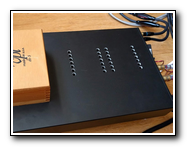
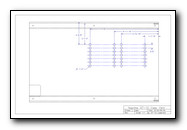
Normally about 15 minutes idle is necessary to optimize the ST-10✝ sonics. July 2018: Zero Rain, Sunny. Media Room very warm. Extended sessions with robust program added an edge to the ST-10✝. The case temperature climbed above 40°C from the normal low 30's, indicating higher internal temperatures. We put the PL5 in its stead. Normally, the PL5 takes about 30 minutes to warm and the sonics stabilize. In the summer heat, almost immediately
dulcet, exactly as first installed summer of 2017. As heat is the enemy of everything electronic, we decided to vent the ST-10✝ case. Post surgery, the case remains in the low 30's and sonics remain as pleasant as ever.
Heat Kills
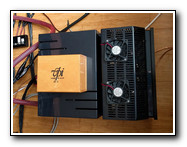

Heat is a killer. But, it takes surprisingly little air to keep most components cool. I discovered this in the early 70's on a Yamaha Class A amp. Passively cooled, it was too hot to touch and component life, particularly electrolytic caps, would be short. Adding a thermostatically controlled fan that barely ticked over kept the beast cool.
The PL5 gets very warm, as do most uncooled tube amps. Adding
The PL5 gets very warm, as do most uncooled tube amps. Adding
two 60x10mm 12VDC 3000 RPM / 15CFM / 26dBA [running on 4.5VDC] fans atop the tube cage keeps the entire chassis just warm. The fans are centered between each pair of output tubes and extract, pulling cool air around the tubes, exhausting air from the chassis via the tube sockets and heat away from the transformer cover. The fans are mounted on compliant spacers and are dead quiet at 1 foot. After many hours, the amp is only warm.
The Force normally runs very cool on most audio program. It's another story with LFE at theater levels. Ditto on some CDs, particularly old remasters with sub audible room noise. The poor driver flops about like a fish out of water and eventually thermal protection activates. With the fan barely ticking over, the heat sink remains cool and program is never interrupted.
The Force normally runs very cool on most audio program. It's another story with LFE at theater levels. Ditto on some CDs, particularly old remasters with sub audible room noise. The poor driver flops about like a fish out of water and eventually thermal protection activates. With the fan barely ticking over, the heat sink remains cool and program is never interrupted.
The Fly in the Ointment...
... and all the while voice coils are changing, always changing, temperature.
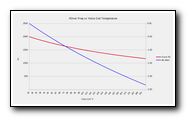
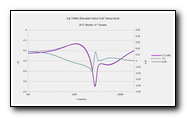
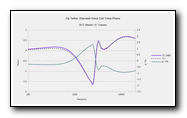
[Click Thumbnails for a larger image]
About 1% of the applied energy is radiated as sound and the rest converted to heat in the voice coil and crossover components. Crossover frequency will shift and output level will decrease due to increased R. Graph shows effect of copper voice coil heating [0.395%/°C] and crossover frequency for a 2KHz 2nd order filter. Effects of crossover component heating ignored.
Coils for various drivers do not heat equally, so an initial 2KHz calculated @ 20°C could become 1850z @ 40°C for the woofer and 1925Hz @ 30°C for the tweeter. Degree of heating is program and level dependent. The blue trace in the first graph is the theoretical woofer attenuation due to the increased resistance. However this new resistance changes the impedance only slightly. This new impedance will interact with the cable and further adjust frequency and phase response.
The 2nd graph shows how the impedance swamps the expected attenuation from R alone, dropping only about 1/2 of the expected value from the first graph. The third graph shows the phase response.
See Stereophile's Hot Stuff: Loudspeaker Voice-Coil Temperatures and 1992 AES paper Heat Dissipation and Power Compression in Loudspeakers for further reading.
Coils for various drivers do not heat equally, so an initial 2KHz calculated @ 20°C could become 1850z @ 40°C for the woofer and 1925Hz @ 30°C for the tweeter. Degree of heating is program and level dependent. The blue trace in the first graph is the theoretical woofer attenuation due to the increased resistance. However this new resistance changes the impedance only slightly. This new impedance will interact with the cable and further adjust frequency and phase response.
The 2nd graph shows how the impedance swamps the expected attenuation from R alone, dropping only about 1/2 of the expected value from the first graph. The third graph shows the phase response.
See Stereophile's Hot Stuff: Loudspeaker Voice-Coil Temperatures and 1992 AES paper Heat Dissipation and Power Compression in Loudspeakers for further reading.
✝ See Done & Dusted for ST-10 failures.
